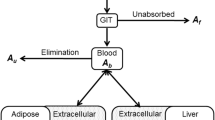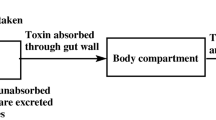Summary
Pharmacokinetic models are presented for the computation of time courses of blood levels of drugs in man following the consumption of contaminated food. Mathematically, two linear systems of differential equations are set up for the donor organism (e.g., trout) and for the recipient, (e.g., man), where the first system generates the initial conditions for the second. Models of this kind are applied to the transfer of chloramphenicol to man via carp and trout (which had previously been administered this drug) and to the transfer of theophylline to infants via breast milk. Limiting concentration profiles are computed by constructing the most favourable and most adverse combinations of parameters with respect to drug elimination in both the donor and recipient organism.
Zusammenfassung
Es werden pharmakokinetische Modelle angegeben, um den Konzentrationsverlauf von Arzneimittelrückständen im Menschen zu berechnen, die mit der Nahrung aufgenommen werden. Dabei lassen sich zwei Kompartimentmodelle für die Kinetik in der Nahrung und im Menschen koppeln: Das erste System liefert die Anfangswerte (bzw. eine Folge von Anfangswerten) für das zweite System. Das Modell wird auf die Übertragung von Chloramphenicol durch Speisefische auf den Menschen und auf die Übertragung von Theophyβin durch die Muttermilch auf gestillte Säuglinge angewendet. Durch Einführung einer günstigsten und ungünstigsten Parameterkombination werden Grenzverläufe für die Blutspiegel berechnet, die als Grundlage einer Rückstandsbewertung dienen können.
Similar content being viewed by others
Literatur
Schmidt Th, Richter O, Büning-Pfaue H (1986) Z Lebensm Unters Forsch 183:325–330
Azzolini F, Gazzaniga A, Ladda E, Natangelo R (1972) Int J Clin Pharmacol 6:130–134
Gladtke E, Hattingberg HM (1973) Pharmakokinetik. Springer, Berlin Heidelberg New York
Richter O, Reinhardt D (1980) Biol Res Pregnancy 1:112–117
Reinhardt D, Richter O (1981) Monatsschr Kinderheilkd 129:341–346
Reinhardt D, Richter O (1984) Pharmacokinetics of translactal passage. In: Kümmerle (ed) Clinical pharmacology in pregnancy. Thieme-Stratton Inc., New York
Klotz U (1974) Klinische Pharmakokinetik, 2. Aufl. Fischer, Stuttgart
Ritschel WA (1976) Handbook of basis pharmakokinetics. Drag Intelligence Publications Inc., Hamilton, IL, USA
Richter O (1982) Mathematische Modelle für die klinische Forschung: enzymatische und pharmakokinetische Prozesse. Monographie, Reihe Medizinische Informatik und Statistik. Springer, Berlin Heidelberg New York
Yurchak M, Jusko JW (1976) Pediatrics 57:518
Giacoia G, Jusko WJ, Menke J, Koup JR (1976) Theophylline pharmacokinetics in premature infants with apnea. Pediatrics 89:829–832
Author information
Authors and Affiliations
Rights and permissions
About this article
Cite this article
Richter, O., Schmidt, T., Büning-Pfaue, H. et al. Wirkstoff-Verbleib nach dem Verzehr rückstandshaltiger Lebensmittel. Z Lebensm Unters Forch 187, 130–136 (1988). https://doi.org/10.1007/BF01042625
Received:
Accepted:
Issue Date:
DOI: https://doi.org/10.1007/BF01042625




